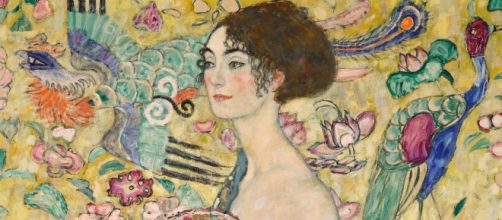This CNN headline was one of those screamers that demanded attention: “Klimt’s ‘last masterpiece’ sells for record-breaking $108.4 million.” The only thing true in those words are the artist’s name and the selling price.
Truth in advertising?
The term “lost masterpiece” gives the impression that the painting “Lady with a Fan” by the 19th-century painter Gustav Klimt had been missing and only now found. No. It sat in plain sight where Klimt left it when he died – on his easel.
The term “lost masterpiece” came from a press release sent to the media by the auction house that sold the work, Sotheby’s, in London.
Although established in 1744, these art brokers come off like used-car salespeople.
“Masterpiece” is not unlike the word "love" – overused and indiscriminately. Here’s Thomas Boyd, Sotheby’s head of Modern Art, explaining in the press release why he thinks "Lady with a Fan" is a masterpiece: “The beauty and sensuality of the portrait lies in the detail: the flecks of blue and pink which enliven the sitter’s skin, the feathery lines of her eyelashes, and the pursed lips that give her face character.”
Does the woman in the painting come through as vivid to you? Do you half expect her to move and speak? Is there anything particularly imaginative about this portrait?
Same old, same old
All the “blue and pink flecks” aside, there’s nothing distinctive here.
What you see is regulation Klimt: a semi-bared female posed against a decorative background.
In this case, the fan covers breasts exposed by a silk robe slipping off her shoulder. The embellished setting is meant to intensify the sensuality of the picture. But it’s too habitual, too practiced to intensify anything.
I’m thinking of “Adele Bloch-Bauer,” whose likeness sits in a profusion of gold. Do the “flecks of blue and pink” in “Lady with a Fan” distinguish it all that much?
I ask this because the sale of “Lady with a Fan” last week made it the costliest picture ever sold at a European auction. And the history-making sale didn’t even take long.
The hammer came down on a bidding war after only 10 minutes.
Three bidders were Asian, but the actual buyer, said to be from somewhere in Asia, was unidentified.
According to a New York Times report, “the audience erupted into thunderous applause that hasn’t been heard at a London auction for some years.” What makes this picture so pricey?
The closest sale price to that of the “Lady with a Fan” was $104.3 million in 2010 for Alberto Giacometti’s sculpture “Walking Man.” Claude Monet’s sale price of $80.4 million in 2008 pales in comparison.
As if to explain the giant sale, former head of modern art at Christie’s, James Roundell, told the Times: “This was Klimt in his later maturity. A decorative element here has found a taste in Asia.”
But wait. “Adele Bloch-Bauer” was painted 11 years earlier than “Lady with a Fan,” yet it bears the same “decorative element.” And the buyer wasn’t Asian.
It was Oprah Winfrey.
Helen Newman, chairman of Sotheby’s Worldwide Head of Modern Art, took her turn at explaining the sale, telling Reuters that “Lady with a Fan” “shows Klimt at the very height of his creative prowess,” pointing out the flowery decoration in the background.
What was the background in “Adele Bloch-Bauer” chopped liver?


